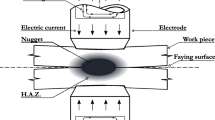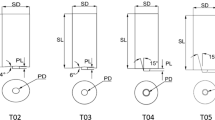Abstract
According to the structure-borne acoustic emission (AE) signals detected in resistance spot welding (RSW) on zinc-coated steel, the main inducing factors of expulsion were analyzed by the mathematical method of orthogonal experimental design (OED) and the analysis of variance (ANOVA) technique. The AE signals of expulsion were used to assess the effect of expulsion on the overload performance of spot welds. The results showed that the expulsion can be analyzed by the waveform of AE signals detected in welding process. The most important factor to induce expulsion was welding current, and the second important factor was electrode pressure. The importance of welding time and the matching of welding current-electrode pressure were close to induce expulsion. An overlarge welding current induced heavy expulsion, which also reduced the strength of spot weld significantly. But, a small expulsion will not significantly affect the strength of spot weld, which made it acceptable to some extent.
Similar content being viewed by others
References
Huh H, Kang WJ (1997) Electrothermal analysis of electric resistance spot welding processes by a 3D finite element method. J Mater Process Technol 63:672–677
Lai XM, Luo AH, Zhang YS, Chen GL (2009) Optimal design of electrode cooling system for resistance spot welding with the response surface method. Int J Adv Manuf Technol 41:226–233
Chao YJ (2003) Failure mode of spot welds: interfacial versus pullout. Sci Technol Weld Join 8(2):133–137
Karimi MR, Sedighi M, Afshari D (2015) Thermal contact conductance effect in modeling of resistance spot welding process of aluminum alloy 6061-T6. Int J Adv Manuf Technol 77:885–895
Sagüés Tanco J, Nielsen CV, Chergui A, Zhang W, Bay N (2015) Weld nugget formation in resistance spot welding of new lightweight sandwich material. Int J Adv Manuf Technol. doi:10.1007/s00170-015-7108-0
Farson DF, Chen JZ, Ely K, Frech T (2003) Monitoring of expulsion in small scale resistance spot welding. Sci Technol Weld Join 8(6):431–436
Pouranvari M, Abedi A, Marashi P, Goodarzi M (2008) Effect of expulsion on peak load and energy absorption of low carbon steel resistance spot welds. Sci Technol Weld Join 13(1):39–43
Zhang HJ, Hou YY, Zhang JY, Qi XY, Wang FJ (2015) A new method for nondestructive quality evaluation of the resistance spot welding based on the radar chart method and the decision tree classifier. Int J Adv Manuf Technol 78:841–851
Le Meur G, Bourouga B, Dupuy T (2003) Measurement of contact parameters at electrode/sheet interface during resistance spot welding process. Sci Technol Weld Join 8(6):415–422
Mei DS, Li DQ, Zhang ZD, Lan L (2009) On-line monitoring method for electrode invalidation during spot welding of zinc-coated steel. Mater Sci Eng A 499:279–281
Cho Y, Kim Z, Rhee S (2001) Development of a quality estimation model using multivariate analysis during resistance spot welding. Proc Inst Mech Eng B 215:1529–1538
Livshits AG (1997) Universal quality assurance method for resistance spot welding based on dynamic resistance. Weld J 76:383s–390s
Jou M (2003) Real time monitoring weld quality of resistance spot welding for the fabrication of sheet metal assemblies. J Mater Process Technol 132:102–113
Kirchheim A, Schaffner G, Staub R, Jeck N (2002) Electrode force as an important process variable in the case of resistance spot welding. Weld Cut 54:130–131
Primoz P, Ivan P, Janez D, Zoran K (2005) Estimating the strength of resistance spot welds based on sonic emission. Sci Technol Weld Join 10(4):399–405
Primoz P, Ivan P, Janez D, Zoran K (2004) Expulsion detection system for resistance spot welding based on a neural network. Meas Sci Technol 15:592–598
Luo Y, Li JL, Wu W (2013) Nugget quality prediction of resistance spot welding on aluminium alloy based on structureborne acoustic emission signals. Sci Technol Weld Join 18(4):301–306
Author information
Authors and Affiliations
Corresponding author
Ethics declarations
Ethical statement
We have read and have abided by the statement of ethical standards for manuscripts submitted to JAMT.
Conflict of interest
The authors declared that they have no conflicts of interest to this work.
Rights and permissions
About this article
Cite this article
Yi, L., Rui, W., Xiaojian, X. et al. Expulsion analysis of resistance spot welding on zinc-coated steel by detection of structure-borne acoustic emission signals. Int J Adv Manuf Technol 84, 1995–2002 (2016). https://doi.org/10.1007/s00170-015-7846-z
Received:
Accepted:
Published:
Issue Date:
DOI: https://doi.org/10.1007/s00170-015-7846-z




